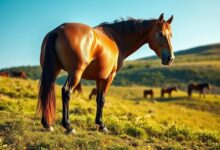Caring for Chestnut Horses: Tips & Essentials
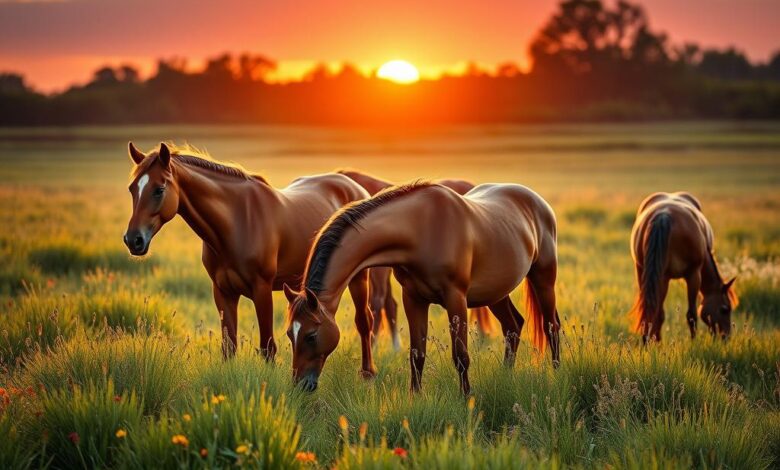
Ever thought about how caring for chestnut horses is different from other breeds? It’s not just interesting; it’s key for their health and joy. These horses, with their special color and needs, need care that matches their unique traits. We’ll share important tips on grooming, feeding, and health for our chestnut friends.
Whether you’re seasoned in horse care or new to it, we aim to boost your knowledge. Our goal is to help you keep your chestnut horses healthy and looking great.
Key Takeaways
- Understanding the unique characteristics of chestnut horses is crucial for effective horse care.
- Proper grooming techniques can enhance the coat’s shine and maintain skin health.
- Nutritional needs for chestnut horses may vary and require specific attention.
- Regular vet check-ups are essential in monitoring health issues common in chestnut horses.
- Creating a safe environment is vital to prevent injuries and ensure well-being.
Understanding Chestnut Horse Characteristics
The chestnut coat color comes in many shades, making horses visually diverse. These shades range from light sorrel to deep liver chestnut. Each shade adds to the horse’s beauty and changes how we groom them.
We need to adjust our grooming based on the horse’s specific chestnut shade. This ensures we care for each horse’s unique needs.
Color Variations in Chestnut Horses
Chestnut horses are found in many breeds. Breed associations define chestnut differently, from reddish-brown to copper. The Suffolk Draught Horse is known only for chestnut coloring.
Other breeds, like Haflingers and American Quarter Horses, often have chestnut coats. This shows how popular chestnut is among horse lovers. Each shade has its own beauty.
Unique Grooming Needs
Grooming chestnut horses requires different approaches for each shade. For example, Haflingers with golden coats need special care. Darker liver chestnuts also have unique grooming needs.
Regular grooming keeps their coats shiny and healthy. This is crucial for all horses, especially those with striking chestnut colors.
Behavior Traits of Chestnut Horses
Chestnut horses often have special behavior traits. They are known for being affectionate and friendly. This makes them great companions.
Knowing these traits helps us train and care for them better. It leads to a strong bond with our chestnut horses.
Essential Nutrition for Chestnut Horses
Nutrition is key for chestnut horses’ health and happiness. Knowing their dietary needs helps them perform well and live long. A balanced diet boosts their energy and vitality. Let’s look at important nutrients, feeding times, and common mistakes to avoid.
Key Nutrients for Optimal Health
For chestnut horse diets, several nutrients are essential:
- Fiber: Horses need 2-2.5% of their body weight in fiber daily for digestive health.
- Protein: They need about 1.4 lbs of protein, often found in high-quality hay like alfalfa.
- Vitamins and Minerals: A mineralized salt block ensures they get essential minerals. Quality forage provides most vitamins and minerals.
- Water: Adequate hydration is crucial. Horses need at least 10 gallons of fresh water daily.
Recommended Feeding Schedule
Feeding at regular times is vital for our horses’ health. Here’s a suggested schedule:
- Morning feeding of hay and concentrates.
- A mid-day check for water and any additional forage.
- Evening serving of fiber, ensuring it aligns with their weight and energy output.
Monitoring their weight helps adjust portion sizes. Talking to a vet or equine nutritionist ensures the diet meets their needs, including their work level and health.
Common Feeding Mistakes to Avoid
While providing proper nutrition, we must avoid common mistakes:
- Overfeeding: This can cause obesity, a common nutrition-related issue in horses.
- Neglecting hydration: Not enough water can lead to serious health problems, especially during exercise or in hot weather.
- Ignoring dental health: A horse that looks skinny despite enough food might have dental problems or internal parasites.
Grooming Techniques Specific to Chestnut Horses
Grooming is key for keeping chestnut horses healthy and looking great. Each horse might need different care based on their coat and condition. Using the right tools and methods can greatly improve their health. Let’s look at the best ways to groom chestnut horses.
Best Brushes and Tools to Use
Choosing the right brushes is crucial for horse skincare. We suggest using:
- A soft bristle brush for the sensitive skin of chestnut horses.
- A curry comb to remove dirt and stimulate natural oils.
- A hoof pick to maintain clean hooves and detect any issues early.
Regular grooming with these tools promotes healthy skin and coat. It also helps spot any wounds or problems that need attention.
Bathing Tips to Enhance Shine
Bathing our chestnut horses not only makes them shine but also keeps their skin healthy. Here are some tips:
- Use specialized shampoos for specific skin issues, if necessary.
- Dilute shampoo to wash dirty patches effectively.
- Rinse thoroughly to prevent residue buildup after bathtime.
Bathing should happen regularly, especially in warmer months. This keeps their coats clean and vibrant.
Maintaining Mane and Tail Health
Caring for a chestnut horse’s mane and tail needs careful attention. Here are our tips:
- Use detanglers such as Quiksilver or Cowboy Magic to ease combing.
- Regularly trim the mane and tail to keep them manageable and healthy.
- Practice braiding skills ahead of time if preparing for shows.
These methods not only make the mane and tail look good. They also add to the grooming routine for our chestnut horses.
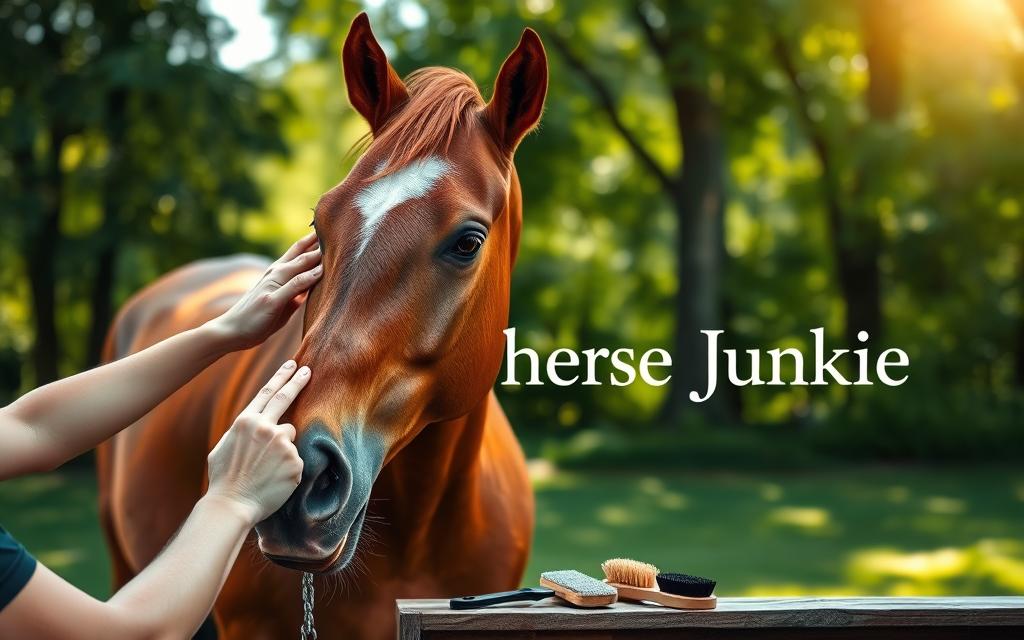
Health Considerations for Chestnut Horses
Keeping our chestnut horses healthy is a big job. We need to watch out for different health problems. Knowing what to look for helps us take good care of them. Regular checks are key to keeping them healthy.
Common Health Issues to Monitor
There are a few chestnut horse diseases we should keep an eye on:
- Colic: A painful condition affecting the digestive tract that can lead to severe complications if not addressed promptly.
- Laminitis: Inflammation of the sensitive laminae within the hoof, often caused by dietary changes or metabolic disorders.
- Skin issues: Allergies or infections can lead to skin irritation, necessitating careful grooming and treatment.
Importance of Regular Vet Check-ups
Regular vet visits are essential for our horses’ health. These visits help catch problems early. This way, we can act fast and keep our horses healthy.
Vaccination and Deworming Guidelines
Sticking to a schedule for equine vaccinations and deworming is important. A vet can help us make a plan that keeps our horses safe. Keeping to this plan helps prevent many health issues.
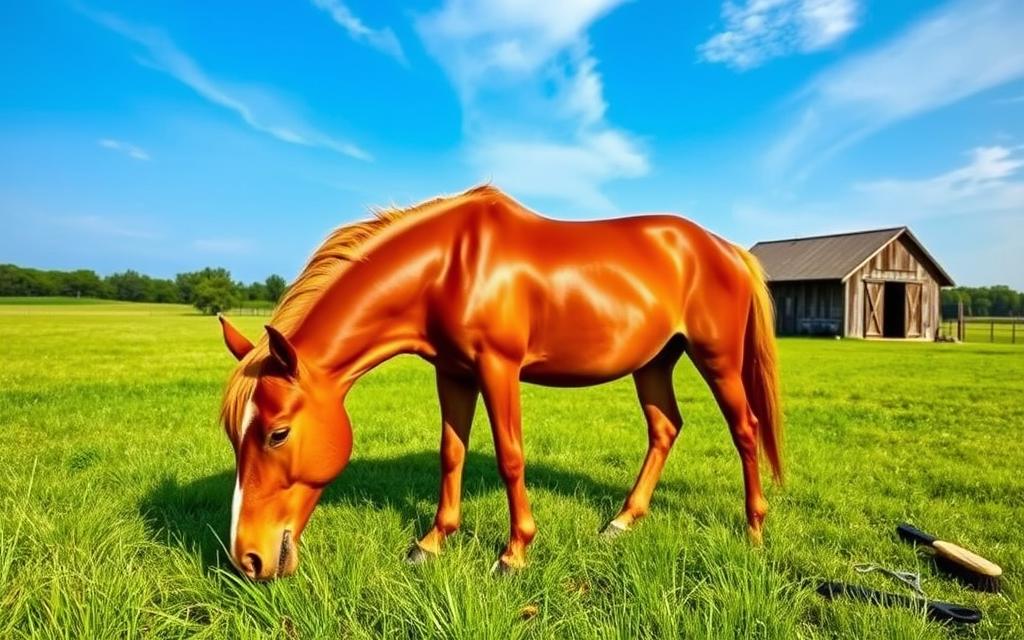
Training Tips for Chestnut Horses
Training chestnut horses needs us to know how they learn and behave. Each horse is different, so we must tailor our training. Building a strong bond through clear communication helps a lot.
Understanding Their Learning Styles
Horses learn in their own ways, and chestnut horses are no exception. They do well with routines and clear signs. We should move slowly and smoothly, like in side passes, to keep them calm.
Being patient and watching how they react is key. We need to adjust our training based on their responses.
Effective Communication Strategies
Clear communication is key when training chestnut horses. We use our body and legs to tell them what to do. It’s important to avoid confusion and keep moving forward.
Groundwork helps us show who’s in charge and builds trust. Knowing each horse’s quirks lets us train them better.
Building Trust and Confidence
Building trust with our chestnut horses makes them more confident. Activities like long-lining or trail riding help them grow. Dealing with stubbornness patiently makes them more willing to learn.
By being clear and consistent, we build trust. This trust leads to better behavior in our horses.
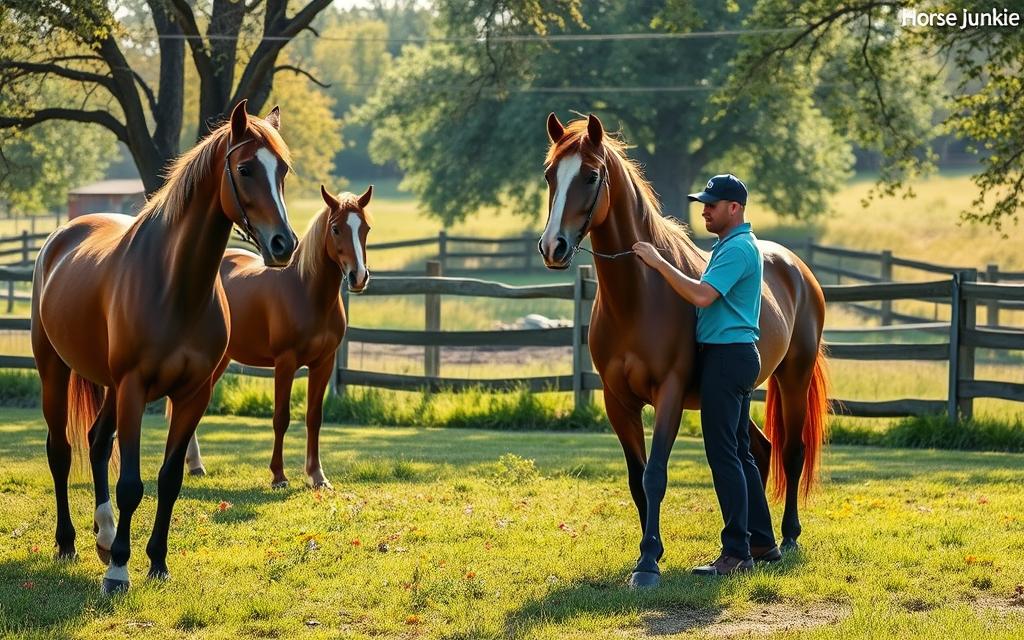
Creating a Safe Environment for Chestnut Horses
It’s vital to make a safe and caring space for our chestnut horses. We focus on stable care and managing pastures. This helps our horses live well without stress or danger.
Essential Stable Features
Designing or keeping a stable right involves several important features. These are key for horse safety:
- Clean bedding to protect against injuries and infection.
- Proper ventilation to prevent respiratory issues.
- Secure fencing to keep horses safe from escaping and outside threats.
An adequately sized shelter, measuring at least 12 by 24 feet, ensures that horses have enough space to move comfortably. Regular inspections of the stables can help us identify and rectify any safety hazards that may arise.
Pasture Care and Maintenance
Keeping our pastures in good shape is key for a safe space. Proper pasture management includes:
- Rotating grazing areas to reduce parasite risk.
- Removing manure regularly to promote health and safety.
- Ensuring adequate space, ideally 1-2 acres per horse, to prevent overcrowding.
Horses need constant access to fresh, clean water. We must frequently check and refill troughs or buckets, especially in colder climates where water may freeze. Providing shade and additional hay during extreme temperatures supports their comfort.
Preventing Injuries in the Field
To lower the risk of injuries in the field, we can take a few steps:
- Regularly inspect fences to prevent escape or injury.
- Avoid overcrowded turnout areas to reduce dominance issues.
- Monitor our horses’ health closely for signs of distress or illness.
By focusing on horse safety through careful stable care and pasture upkeep, we ensure a safe place for our chestnut horses to thrive.
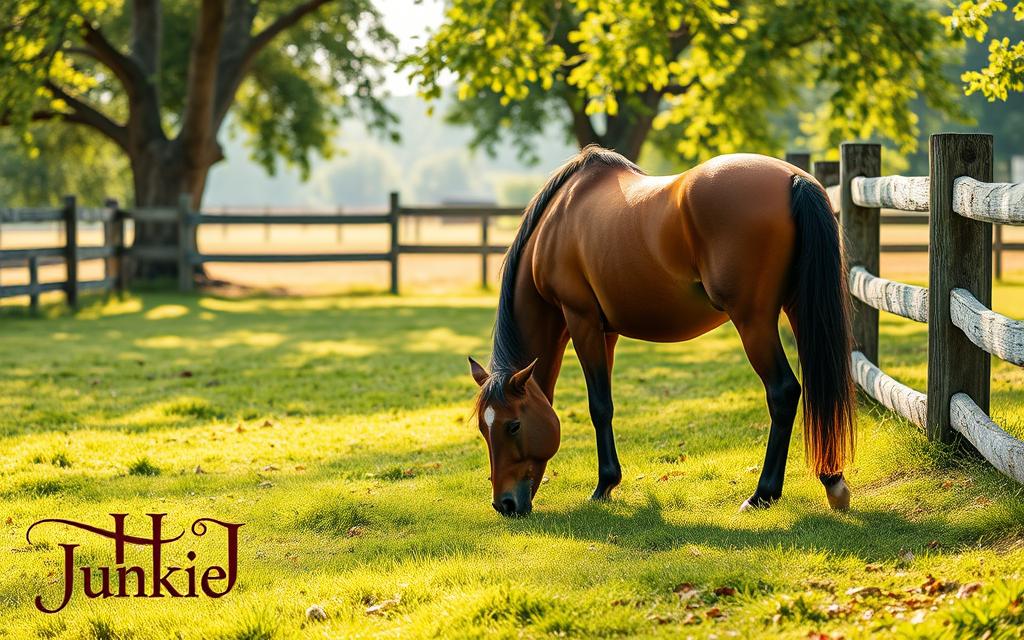
Tack and Equipment for Chestnut Horses
Choosing the right tack for horses is key for comfort and performance, especially for chestnut horses. The right equipment boosts our horses’ confidence and well-being. It’s important to pick the right gear for both function and looks.
Choosing the Right Saddle
When picking a saddle, think about your horse’s body shape and your riding style. A well-fitting saddle spreads weight evenly to avoid discomfort. It’s crucial to avoid saddles that pinch or rub, which can hurt your horse.
Look for saddles like the Weatherbeeta Comfitec Essential Standard Neck Medium, priced at $149.99. It’s known for being comfortable and durable.
Importance of Proper Fit
Proper fit is essential for safe riding. Tack that puts too much pressure on sensitive areas can cause pain or long-term problems. Check your tack regularly for wear and ensure it fits well.
Brands like Weaver Equine offer adjustable tack, like the Weaver Equine Working Tack Straight Browband, priced at $75.99 but discounted to $60.79.
Matching Colors and Styles for Aesthetic Appeal
The look of our equestrian gear is important for our bond with our chestnut horses. Many riders enjoy matching colors, like yellow and pale pink, which look great on chestnut coats. The Weaver Leather Poly Roper Reins, priced at $12.99 but discounted to $10.39, add a fun touch.
Talking about color trends makes our rides more enjoyable and helps build a community around beautiful tack.
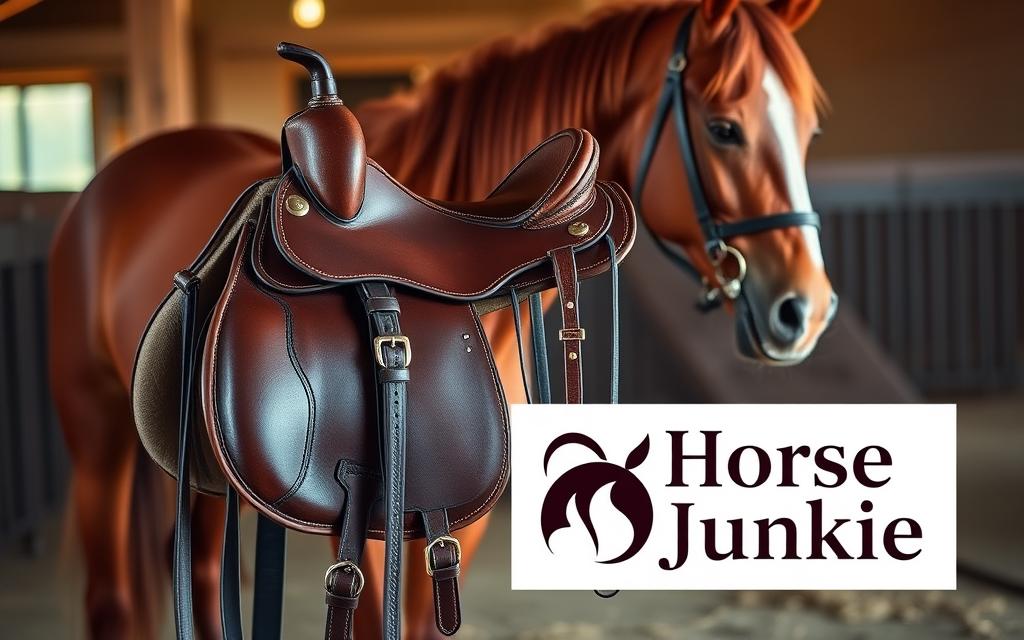
The Importance of Regular Exercise
Keeping our chestnut horses healthy is key, and regular exercise is crucial. It helps improve muscle tone and boosts their overall health. It also keeps their minds sharp.
Benefits for Physical Health
Exercise offers many benefits for our horses. Here are some key advantages:
- Enhances muscle tone: Exercise builds strong muscles, which is important for performance.
- Improves circulation: Movement helps blood and lymph flow, reducing leg swelling and stiffness.
- Prevents obesity: Enough exercise helps prevent weight gain and related health problems like laminitis.
- Supports joint health: Activities like groundwork keep joints and muscles fit.
- Reduces stress: Regular movement helps solve behavioral issues caused by boredom and confinement.
Fun Activities to Engage Them
Adding fun activities to our horses’ routines keeps them active and happy. Here are some ideas:
- Trail rides: Exploring new places is a great challenge for both body and mind.
- Obstacle courses: Setting up obstacles is a fun way to keep them active and mentally sharp.
- Groundwork and clicker training: These methods are low-impact and help strengthen the bond between horse and rider.
- Swimming: Swimming or using underwater treadmills is a low-impact way to condition them.
Setting an Exercise Routine
Creating a regular exercise plan is essential for our horses’ health. Here are some tips to help:
- Start with 20 minutes of movement daily, then increase as needed.
- In cooler weather, add extra time for a brisk walk to warm up.
- Make sure they stay hydrated, especially in hot weather, by offering electrolytes.
- Get a vet’s approval before starting any exercise program.
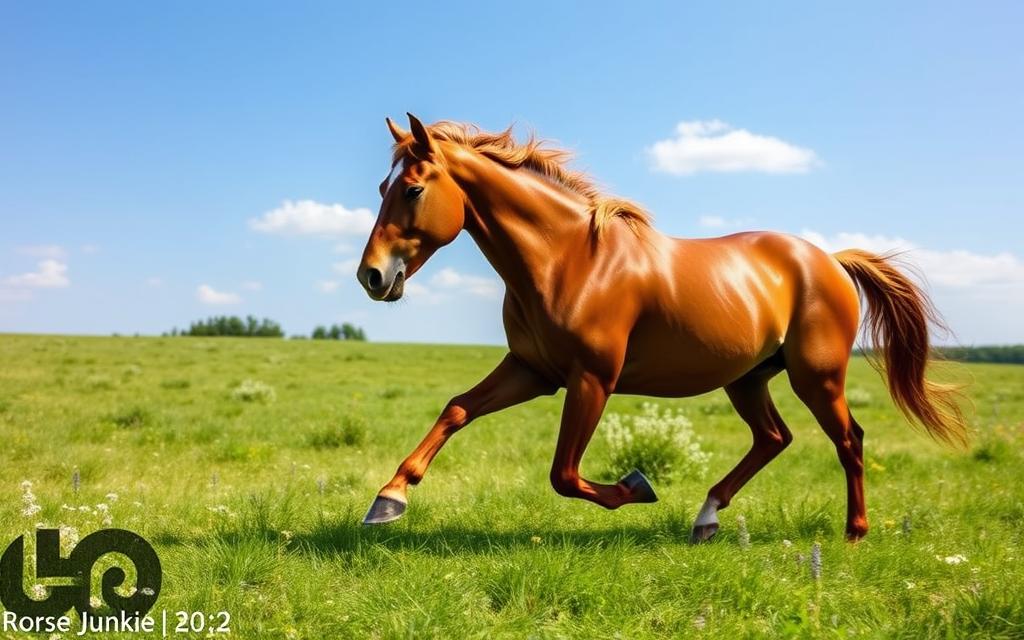
Monitoring Behavior and Mood Changes
Watching our horses closely is key to their happiness. Spotting mood changes can help us catch stress or discomfort early. This way, we can help our horses stay mentally healthy.
Recognizing Signs of Stress or Discomfort
Knowing how horses act helps us see when they’re stressed. Look out for these signs:
- Unusual sounds, like too much neighing or whinnying
- Changes in eating habits, like not wanting to eat or drink
- Changes in how they act with others, like pulling away from friends
- Physical signs, like tight muscles or twitching ears
Techniques to Promote Well-being
To make our horses happy, we can enrich their environment and use positive training. Here are some ideas:
- Give them toys and fun activities to keep their minds busy
- Make sure they have a cozy place to live with enough room
- Keep a regular schedule to help them feel secure
- Let them hang out with other horses often
When to Seek Professional Help
If our horses show signs of stress or act differently for a long time, it’s time to get help. Experts like equine behaviorists or vets can help us understand and fix the problem. Catching issues early is crucial to keep our horses happy and healthy.
Building a Strong Bond with Our Chestnut Horses
A strong bond with our chestnut horses makes handling and riding better. We can do many things to connect and understand each other. Starting this bond means knowing how a horse feels, which comes from early care and imprinting.
Everyone’s experience with bonding is different, depending on the horse.
Activities to Foster Connection
Doing certain activities helps us bond with horses. Some good ways include:
- Groundwork exercises that promote trust and communication.
- Walking with our horses to build ground manners and to enjoy nature together.
- Horse agility tasks for a playful engagement that encourages cooperation.
- Implementing positive reinforcement or clicker training for effective learning.
Understanding Body Language
Knowing horse body language helps us connect. Signs of love and comfort are:
- Softening their gaze or nuzzling against us.
- Grooming us when within reach, demonstrating companionship.
- Whinnying without prompting to seek interaction.
- Turning toward us in times of stress, showcasing trust.
- Following us around, indicating a strong bond.
The Role of Consistency and Patience
Being consistent and patient is key in horse care. Setting clear rules and reminding horses of them shows respect. This builds a strong bond and helps during training.
A deep connection creates trust. This trust makes our horses more willing to cooperate, even when things get tough.
Community and Resources for Chestnut Horse Owners
Being part of a horse owner community is key for growing our knowledge and skills. Connecting with local groups lets us share advice, experiences, and challenges. We can find these communities at local equestrian centers, online forums, or meetups.
Expanding our network means we get more support and insights into managing our horses.
Finding Local Support Groups
Joining local groups can make our journey as chestnut horse owners better. We can talk about grooming, nutrition, and more. Plus, it helps us make friends and learn from others’ experiences.
Recommended Books and Online Resources
There are many resources to learn more about horse care and training. Websites like TheHorse.com offer free articles on horse health and management. Books by equine experts are also great for learning about nutrition and training.
Events and Competitions to Engage With
Events and competitions let us show off our chestnut horses and meet others. They’re chances to learn and improve our skills. Whether it’s local shows or community rides, they make our experience richer.
FAQ
What are the different shades of chestnut horses and their grooming needs?
How should I feed my chestnut horse for optimal health?
What are the grooming essentials for maintaining a chestnut coat?
What health issues should I monitor in my chestnut horse?
How can I create a safe and comfortable environment for my chestnut horse?
What types of tack are best suited for chestnut horses?
Why is regular exercise important for chestnut horses?
How can I recognize signs of stress or discomfort in my chestnut horse?
How can I strengthen the bond with my chestnut horse?
What resources are available for chestnut horse owners?
Source Links
- HORSE CHESTNUT: Overview, Uses, Side Effects, Precautions, Interactions, Dosing and Reviews
- The Ultimate Guide To Chestnut Horse Breeds | Strathorn Farm
- What Is a Chestnut on a Horse? Significance & Care Explained — The Equine Institute
- Can someone please explain to me the chestnut hate?
- Equine Nutrition 101: A Beginner’s Guide to Feeding Your Horse
- A Beginner’s Guide to Equine Nutrition & Feeds
- Keeping Chestnut Horses Shiny and Bright
- A Healthy Coat Means a Happy Horse
- Minimal grooming routine for shows
- Horse chestnut: Benefits and risks
- Training Refocus
- Preventing back talk in the chestnut mare
- How to Handle a Disease Outbreak on a Horse Farm�
- Does Your Horse Need a Barn?�
- Horse Tack
- Chestnut Horse Tack
- Best Tack Colors for Chestnut Horses
- On the Move: The Importance of Regular Exercise for Horses
- The Importance of Warming Up and Cooling Down Your Horse�
- The Importance of Exercise for Your Horse
- Sensory Abilities of Horses and Their Importance for Equitation Science
- Age-Related Changes in the Behaviour of Domestic Horses as Reported by Owners
- Is your horse normal? Now there’s an app for that
- Connecting with Your Horse
- 7 Ways to Bond With Your Horse (Without Riding!)
- 10 Resources on Creating a Horse Facility from TheHorse.com
- Adoption Connections – Exodus Farms




